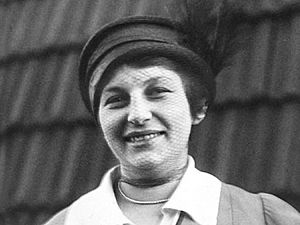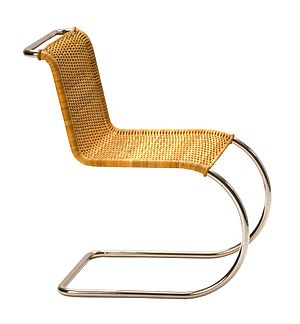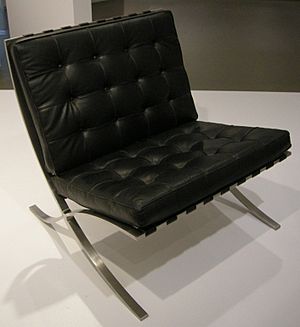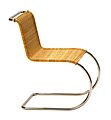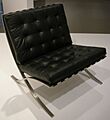Lilly Reich facts for kids
Lilly Reich was a talented German designer who lived from 1885 to 1947. She was a very important figure in the modern design movement. For over ten years, she worked closely with the famous architect Ludwig Mies van der Rohe. Together, they created many groundbreaking designs.
Contents
Her Life and Career
Lilly Reich was born in Berlin, Germany, on June 16, 1885. She first trained in embroidery. In 1908, she went to Vienna to work for the Wiener Werkstätte. This was a famous company of designers and artists.
By 1911, Lilly returned to Berlin. There, she started designing furniture and clothes. She also worked as a decorator for shop windows. In 1912, she joined the Deutscher Werkbund. This German group aimed to make German products better and more competitive. That same year, she designed a model apartment for working-class people. It was praised for being clear and practical.
In 1920, Lilly Reich made history. She became the first woman elected to the governing board of the Deutscher Werkbund. This was a big achievement for a woman at that time.
Working with Trade Fairs
From 1924 to 1926, Lilly worked at the Trade Fair Office in Frankfurt. She was in charge of organizing and designing trade fairs. This is where she met Ludwig Mies van der Rohe. He was the vice president of the Deutscher Werkbund.
Their meeting started a long and important partnership. They worked together on many projects. In 1927, they designed "Die Wohnung" (The Apartment) in Stuttgart. Lilly created several interiors for this exhibition. She also designed store windows, exhibition displays, and fashion throughout her career.
The Barcelona Exposition
In 1929, Lilly became the artistic director for Germany's part in the 1929 Barcelona International Exposition. Mies van der Rohe designed his famous pavilion there. This is also where the well-known Barcelona chair was first shown. Their work at this exposition was considered a highlight of their design efforts.
Teaching and Later Years
In 1932, Mies van der Rohe asked Lilly Reich to teach at the Bauhaus. The Bauhaus was a very famous design school. She directed the interior design workshop there. However, the Nazis closed the Bauhaus in 1933.
In 1938, before World War II started, Mies van der Rohe moved to the United States. Lilly stayed in Germany. She visited him in the U.S. in 1939 but returned to Berlin.
Her studio was destroyed by bombs in 1943. She was then forced to work in a labor organization until 1945. After the war, she helped bring back the Deutsche Werkbund. Sadly, she became ill and passed away in Berlin in 1947.
Her Design Style
Lilly Reich started her career designing textiles and women's clothes. This early experience was very important for her. It gave her a special interest in how different textures and materials felt and looked together. She also became very skilled at using fabrics in furniture design.
She worked in the studio of Josef Hoffmann in Vienna starting in 1908. Hoffmann was a well-known modernist designer.
Making a Name for Herself
In 1912, Lilly designed popular interiors for a worker's apartment and two stores. These were part of an exhibition called Die Frau in Haus und Beruf (Woman at Home and at Work). That same year, she joined the Deutscher Werkbund. This group worked to improve German products and designs.
As a board member of the Werkbund, Lilly planned and organized design exhibits. These shows promoted German designers both in Germany and in other countries.
In 1921–22, Lilly organized two large exhibitions for the Newark Museum in the United States. One show focused on women's clothing and accessories. It aimed to bring back German fashion. The second show was huge, with over 1,600 objects. It showed the quality of German industrial design. Even though there was some anti-German feeling after World War I, the show greatly influenced American design.
Exhibitions and Shows
Lilly Reich designed clothing displays for Wertheim, a department store, in 1911. She also worked with German retailers to create modern window displays.
One of her biggest exhibitions was at the International Exposition of 1929 in Barcelona. Here, she showed how important it was to connect design with industry and mass production. She displayed many mass-produced items neatly stacked. This showed how individual units could become part of a larger, abstract image.
Later, in 1937, Lilly had an installation at the 1937 Paris World's Fair. Her work was part of the German pavilion there.
Other important works include:
- German People – German Work, 1934
- The Dwelling in Our Time Berlin, 1931. This included a "Material Show" with a wood exhibit.
- Lilly Reich, Elephant Pharmacy, Berlin 1913.
Lilly Reich and Ludwig Mies van der Rohe
Lilly Reich met Ludwig Mies van der Rohe through her work with the Werkbund. In 1926, she moved to Berlin to work with him. They were partners, both personally and professionally, for 13 years. This was from 1925 until Mies moved to the U.S. in 1938.
They worked together constantly. They curated and set up exhibitions for the Werkbund. They also designed modern furniture for bigger architectural projects. These included the Barcelona Pavilion in 1929 and the Tugendhat House in Brno. Two of their most famous furniture designs from this time are the Barcelona Chair and the Brno Chair.
Many experts believe that Mies van der Rohe's success in exhibition design grew significantly when he worked with Lilly Reich. He did not fully develop successful modern furniture designs before or after their collaboration.
When Mies van der Rohe became the director of the Bauhaus School in 1930, Lilly Reich joined him. She was one of the few female teachers there. Reich taught interior design and furniture design.
In 1996, the Museum of Modern Art (MoMa) in New York held an exhibition about her work. It was called "Lilly Reich: Designer and Architect." This show helped bring attention to this important designer, who had been almost forgotten.
Lilly Reich traveled to the United States, England, and Austria. She studied and worked with other designers of her time. She also organized exhibitions for the German government.
In 2018, the Mies van der Rohe Foundation in Spain created the Lilly Reich Grant. This grant helps people study Lilly Reich's work. It aims to share more knowledge about her important role in modern architecture.
Images for kids
See also
 In Spanish: Lilly Reich para niños
In Spanish: Lilly Reich para niños


